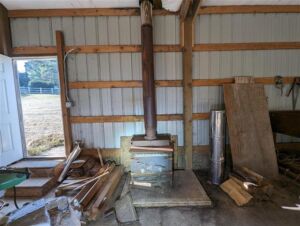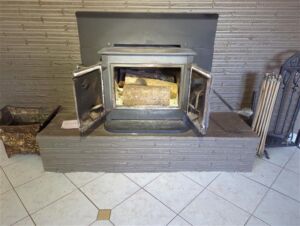
Old wood stoves can pose immediate and significant risks, especially in terms of potential fires. These stoves often lack modern safety features, making them susceptible to overheating and igniting nearby combustible materials. Additionally, the deterioration of important components like gaskets and seals over time poses an increased danger of hazardous leaks and sparks. Many older wood stoves lack proper insulation. This can lead to the outward radiation of heat, posing a fire hazard to nearby walls, floors, and other combustible materials. To address this risk, homeowners might need to make costly investments in insulation upgrades.
Old wood stoves are known for their inefficient performance, as they consume more wood while producing less heat compared to modern counterparts. The inefficiency of these stoves poses a dual concern – it strains your wallet and contributes to environmental issues. Burning excess wood leads to the generation of increased smoke, particulate matter, and greenhouse gas emissions, which in turn worsen air quality and contribute to climate change.

Burning wood in old stoves can also release harmful pollutants such as fine particulate matter and volatile organic compounds (VOCs) into your indoor air. Long-term exposure to these indoor pollutants can lead to a range of potentially serious health problems. Children, the elderly, and individuals with preexisting health conditions are particularly vulnerable to poor indoor air quality.
The advantage of modern wood stoves is that they are subject to stringent emissions standards and safety regulations designed to protect both the environment and human health. Older wood stoves usually do not meet these standards, and are sometimes required to be removed. Failure to remove old wood stoves when required can result in fines, or even legal action. This adds to the overall cost and inconvenience of maintaining an old wood stove.
You should also consider that as wood stoves age, they require more frequent and costly repairs and maintenance. Finding replacement parts for older models can be difficult and expensive. Hiring professional technicians to service them can cost more than maintenance and servicing of a modern stove that does not need as much work. This is because modern wood stoves are designed with user-friendly features and durable materials which reduces the need for maintenance.
While old wood stoves may evoke a sense of nostalgia and charm, they can have hidden risks that homeowners should be aware of. From fire hazards to health concerns and regulatory issues, these old appliances often fall short of modern safety and efficiency standards. To improve the safety of your home and the well-being of your family, you may wish to consider upgrading to a newer, more efficient wood stove.
Alternative heating options such as pellet stoves, gas stoves, or electric heaters also exist. For example, pellet stoves offer a significant advantage over traditional wood stoves in terms of ease and safety. Pellet stoves are automated and come equipped with features like programmable thermostats and automatic ignition systems. This automation ensures a consistent and controlled burn, reducing the risk of overheating and potential fires. The pellets themselves are cleaner and easier to handle than firewood and because of the tightly sealed hopper system in pellet stoves, the risk of indoor air pollution is reduced.
By prioritizing safety and sustainability, you can enjoy a warm and cozy home without compromising on health or the environment
